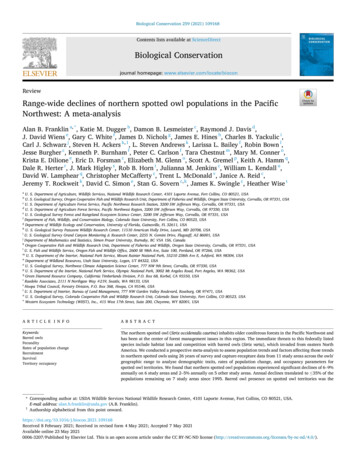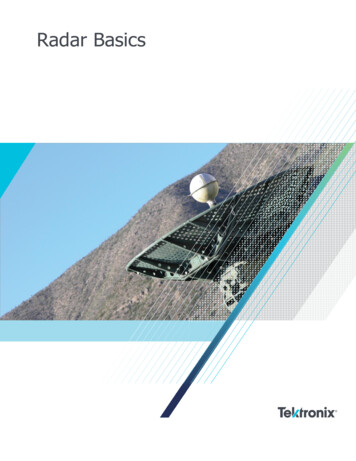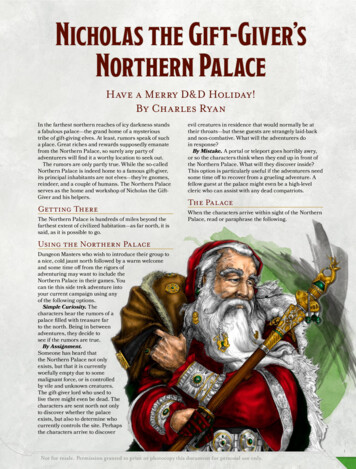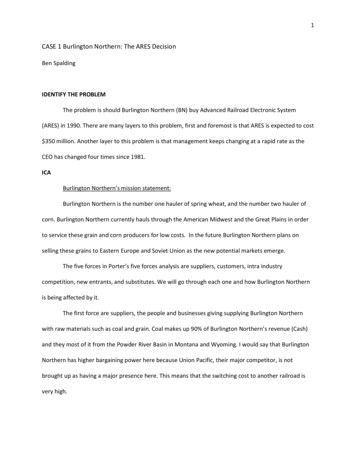
Transcription
Biological Conservation 259 (2021) 109168Contents lists available at ScienceDirectBiological Conservationjournal homepage: www.elsevier.com/locate/bioconReviewRange-wide declines of northern spotted owl populations in the PacificNorthwest: A meta-analysisAlan B. Franklin a, *, Katie M. Dugger b, Damon B. Lesmeister c, Raymond J. Davis d,J. David Wiens e, Gary C. White f, James D. Nichols g, James E. Hines h, Charles B. Yackulic i,Carl J. Schwarz j, Steven H. Ackers k, 1, L. Steven Andrews k, Larissa L. Bailey f, Robin Bown l,Jesse Burgher c, Kenneth P. Burnham f, Peter C. Carlson f, Tara Chestnut m, Mary M. Conner n,Krista E. Dilione e, Eric D. Forsman c, Elizabeth M. Glenn o, Scott A. Gremel p, Keith A. Hamm q,Dale R. Herter r, J. Mark Higley s, Rob B. Horn t, Julianna M. Jenkins c, William L. Kendall u,David W. Lamphear q, Christopher McCafferty c, Trent L. McDonald v, Janice A. Reid c,Jeremy T. Rockweit k, David C. Simon e, Stan G. Sovern c, k, James K. Swingle c, Heather Wise taU. S. Department of Agriculture, Wildlife Services, National Wildlife Research Center, 4101 Laporte Avenue, Fort Collins, CO 80521, USAU. S. Geological Survey, Oregon Cooperative Fish and Wildlife Research Unit, Department of Fisheries and Wildlife, Oregon State University, Corvallis, OR 97331, USAcU. S. Department of Agriculture Forest Service, Pacific Northwest Research Station, 3200 SW Jefferson Way, Corvallis, OR 97331, USAdU. S. Department of Agriculture Forest Service, Pacific Northwest Region, 3200 SW Jefferson Way, Corvallis, OR 97330, USAeU. S. Geological Survey Forest and Rangeland Ecosystem Science Center, 3200 SW Jefferson Way, Corvallis, OR 97331, USAfDepartment of Fish, Wildlife, and Conservation Biology, Colorado State University, Fort Collins, CO 80523, USAgDepartment of Wildlife Ecology and Conservation, University of Florida, Gainesville, FL 32611, USAhU. S. Geological Survey Patuxent Wildlife Research Center, 11510 American Holly Drive, Laurel, MD 20708, USAiU. S. Geological Survey Grand Canyon Monitoring & Research Center, 2255 N. Gemini Drive, Flagstaff, AZ 86001, USAjDepartment of Mathematics and Statistics, Simon Fraser University, Burnaby, BC V5A 1S6, CanadakOregon Cooperative Fish and Wildlife Research Unit, Department of Fisheries and Wildlife, Oregon State University, Corvallis, OR 97331, USAlU. S. Fish and Wildlife Service, Oregon Fish and Wildlife Office, 2600 SE 98th Ave, Suite 100, Portland, OR 97266, USAmU. S. Department of the Interior, National Park Service, Mount Rainier National Park, 55210 238th Ave E, Ashford, WA 98304, USAnDepartment of Wildland Resources, Utah State University, Logan, UT 84322, USAoU. S. Geological Survey, Northwest Climate Adaptation Science Center, 777 NW 9th Street, Corvallis, OR 97330, USApU. S. Department of the Interior, National Park Service, Olympic National Park, 3002 Mt Angeles Road, Port Angeles, WA 98362, USAqGreen Diamond Resource Company, California Timberlands Division, P.O. Box 68, Korbel, CA 95550, USArRaedeke Associates, 2111 N Northgate Way #219, Seattle, WA 98133, USAsHoopa Tribal Council, Forestry Division, P.O. Box 368, Hoopa, CA 95546, USAtU. S. Department of Interior, Bureau of Land Management, 777 NW Garden Valley Boulevard, Roseburg, OR 97471, USAuU. S. Geological Survey, Colorado Cooperative Fish and Wildlife Research Unit, Colorado State University, Fort Collins, CO 80523, USAvWestern Ecosystem Technology (WEST), Inc., 415 West 17th Street, Suite 200, Cheyenne, WY 82001, USAbA R T I C L E I N F OA B S T R A C TKeywords:Barred owlsFecundityRates of population changeRecruitmentSurvivalTerritory occupancyThe northern spotted owl (Strix occidentalis caurina) inhabits older coniferous forests in the Pacific Northwest andhas been at the center of forest management issues in this region. The immediate threats to this federally listedspecies include habitat loss and competition with barred owls (Strix varia), which invaded from eastern NorthAmerica. We conducted a prospective meta-analysis to assess population trends and factors affecting those trendsin northern spotted owls using 26 years of survey and capture-recapture data from 11 study areas across the owls'geographic range to analyze demographic traits, rates of population change, and occupancy parameters forspotted owl territories. We found that northern spotted owl populations experienced significant declines of 6–9%annually on 6 study areas and 2–5% annually on 5 other study areas. Annual declines translated to 35% of thepopulations remaining on 7 study areas since 1995. Barred owl presence on spotted owl territories was the* Corresponding author at: USDA Wildlife Services National Wildlife Research Center, 4101 Laporte Avenue, Fort Collins, CO 80521, USA.E-mail address: alan.b.franklin@usda.gov (A.B. Franklin).1Authorship alphabetical from this point 8Received 8 February 2021; Received in revised form 4 May 2021; Accepted 7 May 2021Available online 23 May 20210006-3207/Published by Elsevier Ltd. This is an open access article under the CC BY-NC-ND license ).
A.B. Franklin et al.Biological Conservation 259 (2021) 109168primary factor negatively affecting apparent survival, recruitment, and ultimately, rates of population change.Analysis of spotted and barred owl detections in an occupancy framework corroborated the capture-recaptureanalyses with barred owl presence increasing territorial extinction and decreasing territorial colonization ofspotted owls. While landscape habitat components reduced the effect of barred owls on these rates of decline,they did not reverse the negative trend. Our analyses indicated that northern spotted owl populations potentiallyface extirpation if the negative effects of barred owls are not ameliorated while maintaining northern spotted owlhabitat across their range.1. Introductionfactors affecting these trends? We addressed the first broad question byexamining a number of more specific questions, including: What are thetrends in life history traits, such as fecundity, survival, and recruitment? andWhat are the annual rates of population change? To address the secondbroad question, hypotheses about range-wide factors, such as habitat,climate, and invasive species, are addressed in the meta-analysis, espe cially those factors previously identified as threats to population re covery (e.g., Dugger et al., 2016; Forsman et al., 2011). Threats to NSOpopulations have changed since the first several meta-analyses (Table 1)with habitat loss and fragmentation considered the primary threats inthe 1980s and 1990s (U. S. Fish and Wildlife Service, 1990). Since theadoption of the NWFP, timber harvesting declined on federal lands,which slowed the threat of alteration and removal of suitable forest forNSO on federal lands. Concurrently, barred owls (Strix varia; BO) fromthe eastern U. S. began expanding their distribution and increasing innumbers throughout the Pacific Northwest (Kelly et al., 2003; Long andWolfe, 2019). In the last two decades, BOs have been considered a pri mary threat to NSO populations (U. S. Fish and Wildlife Service, 2011,2020), through both interference and exploitative competition (Les meister et al., 2018; Van Lanen et al., 2011; Wiens et al., 2014). Relativeto NSO, congeneric BOs are larger, use smaller home ranges, and have abroader (generalist) diet that includes numerous small mammalian preyimportant to NSO (Gutiérrez et al., 2007; Hamer et al., 2001; Wienset al., 2014). BOs are also behaviorally dominant to NSO during terri torial confrontations (Van Lanen et al., 2011), and where the two speciesco-occur they exhibit a high degree of overlap in patterns of habitatselection at nesting sites and foraging areas (Long and Wolfe, 2019;Wiens et al., 2014). This combination of exploitation and interferencecompetition, coupled with rapidly increasing numbers of BOs in olderforests throughout the Pacific Northwest, has exacerbated NSO popu lation declines historically triggered by habitat loss.In the last meta-analysis, BOs were identified as a primary influencenegatively affecting life history traits, territory occupancy rates, and,ultimately, rates of population change in NSOs (Dugger et al., 2016).Recently, the U.S. Fish and Wildlife Service determined that the NSOwas warranted for uplisting to endangered, but this re-classification wasprecluded by other higher priority listings (U. S. Fish and Wildlife Ser vice, 2020). This, coupled with the recent elimination of 14,050 km2 ofcritical habitat for the NSO (U. S. Fish and Wildlife Service, 2021),makes it imperative to understand current population trends and thefactors affecting those trends for this species.The meta-analysis presented here follows the same general guide lines as preceding meta-analyses on NSO populations to objectivelyevaluate trends in population parameters and competing hypothesesrepresenting different effects that can influence those trends (Andersonet al., 1999). We used rigorous analytical methods, such as random ef fects, and approaches that accounted for imperfect detectability, such ascapture-recapture and occupancy modeling. In keeping with previousmeta-analyses, we also incorporated recent innovations in statisticalanalyses to provide a rigorous analytical approach.The northern spotted owl (Strix occidentalis caurina; NSO) inhabitsconiferous forests in the Pacific Northwest of the U.S., extending fromBritish Columbia through Washington and Oregon and into northernCalifornia (Gutiérrez et al., 1995). This subspecies has been at the nexusof forest management issues in the Pacific Northwest since the 1970sbecause of its strong association with older forests coupled with rela tively large home ranges. In 1990, the NSO was listed as threatenedunder the Endangered Species Act (U. S. Fish and Wildlife Service, 1990)and protection of older forests for NSO and other old-forest obligatesreduced timber harvest (Dixon and Juelson, 1987). Multiple manage ment strategies and plans were developed by federal agencies on whoselands the bulk of NSO populations were found. Most of these manage ment plans were litigated, especially after the owl was federally listed(Marcot and Thomas, 1997). In 1994, the Northwest Forest Plan (NWFP)was adopted, which attempted to balance maintenance of forests forNSO populations with economically viable timber harvest on federallands throughout the owls' range; current forest management continuesunder this plan (U. S. Department of Agriculture and U. S. Department ofthe Interior, 1994).One component of the NWFP required long-term monitoring of NSOpopulations (Lint et al., 1999). This monitoring scheme utilized eightexisting NSO demographic studies that were established as early as1985. Additional demographic studies were also initiated outside theNWFP population monitoring framework and, at one point, there were15 demographic studies distributed across the range of the NSO(Franklin et al., 1999). These studies were alike in that all utilizedsimilar field methods to estimate demographic parameters using pri marily capture-recapture estimators (Franklin et al., 1996).Collectively, the demographic studies of the NSO were considered asmeta-replicates, where the study area was the unit of replication(Johnson, 2002, 2006). This allowed for a prospective meta-analysis(Seidler et al., 2019) of NSO demographic studies, where study areaselection, hypotheses, and analyses were specified before the metaanalysis was conducted (e.g., Anthony et al., 2006). Although rare,prospective meta-analyses are useful for addressing high-priorityresearch questions in situations where new studies are expected toemerge (Seidler et al., 2019).We provide here the results from the seventh meta-analysis onpopulation trends in NSOs (Table 1). This meta-analysis continued thetradition of earlier meta-analyses in addressing two key questions ofconcern to forest and wildlife managers: What are the range-wide popu lation trends in NSO populations? and Are management activities or otherTable 1History of meta-analyses to estimate range-wide population trends in northernspotted owls.YearNo. of study areasNo. of 151411111112474444433840Anderson and Burnham (1992)Forsman et al. (1996b)Franklin et al. (1999)Anthony et al. (2006)Forsman et al. (2011)Dugger et al. (2016)Current studya2. Methods2.1. Study areasWe used 11 study areas where demographic data were collected onNumber of participants at the analytical workshops.2
A.B. Franklin et al.Biological Conservation 259 (2021) 109168NSOs (3 in Washington, 5 in Oregon, and 3 in California) through 2018(Table 2, Fig. 1). Although the duration of these studies ranged from 27to 34 years, we used 1993 as the starting year for all the study areasbecause it provided a common time period for analyses and allowed forcomparisons among study areas that began in different years (Fig. 2; 26years: 1993–2018). Eight of the 11 study areas (OLY, CLE, COA, HJA,TYE, KLA, CAS, NWC) were part of the NWFP Effectiveness MonitoringProgram (Lint et al., 1999). Of these eight study areas, the OLY, HJA,CAS, and NWC study areas were primarily on federal public lands whilethe CLE, COA, TYE, and KLA study areas were on a mixture of federaland private lands. The 3 study areas not included in the NWFP Moni toring Program were on lands owned by Green Diamond ResourceCompany (GDR) and the Hoopa Tribe Reservation (HUP), both in Cali fornia. Also, the RAI study area in Washington included lands managedby Weyerhaeuser Company, the National Park Service, the U.S. ForestService, and Hancock Forest Management. The study areas were large(356–3922 km2; Table 2) and were distributed across the range of theNSO, which encompassed different climatic, topographic, vegetative,and elevation regimes (Fig. 1, Table 2; see Anthony et al. (2006) forstudy area details). Since the last meta-analysis (Dugger et al., 2016), theCAS study area was reduced from 3377 to 2372 km2 because areassurveyed for spotted owls by the Bureau of Land Management (BLM) andNational Park Service (NPS) were reduced or discontinued after 2013and subsequently eliminated from the CAS data. Thus, the CAS datawere reduced in spatial and temporal scope during this current metaanalysis. In addition, Green Diamond Resource Company discontinuedmonitoring spotted owls on 100 km2 of the GDR study area since the lastmeta-analysis, which eliminated about 30 NSO territories that wereincluded in the previous meta-analysis. For the analyses describedbelow, we included the data associated with those owls and territoriesuntil monitoring was discontinued.The 11 study areas in our analysis were not selected randomly (seeAnthony et al., 2006; Dugger et al., 2016; Forsman et al., 2011; Franklinet al., 1996), but this collection of study areas sampled most of thegeographic provinces within the range of the NSO (Fig. 1, Table 2).Combined, these study areas covered about 8% (18,683 km2/230,690km2) of the range of the NSO, and the percentages of suitable NSOhabitat on the study areas were similar to those of the surroundinglandscape of federal lands (Appendix F in Anthony et al., 2006). Thesethree lines of evidence suggest that habitat conditions within the studyareas on federal lands were representative of forest and general condi tions on federal lands within the geographic range of the owl. The GDRand HUP were on non-federal lands, where forests were activelymanaged while maintaining protections for NSOs and their forestedhabitat.Since the last meta-analysis (Dugger et al., 2016), active BO removalsoccurred on portions of the CLE, COA, and HUP study areas as part of aremoval experiment estimating the effects of BOs on NSO populations(U. S. Fish and Wildlife Service, 2013; Wiens et al., 2019, 2020). BOremovals occurred on the GDR study area from 2009–2014. Data fromareas where BOs were removed were censored from our meta-analysisbeginning in the year of first removal and including all subsequentyears, regardless of whether removals were later discontinued (e.g.,GDR; Fig. 2). BOs were removed over the entire HUP study area startingin late 2013, so NSO demographic data collected from 2014–2018 werenot included in our analyses (Fig. 2). Both CLE and COA were split intocontrol and removal areas starting in 2016 (Fig. 2). While both controland removal areas were surveyed for BOs and NSOs in 2016–2018, onlythe control portions of these study areas were included in the metaanalysis, with a study area contraction starting the first field seasonafter removals began. The area of the GDR involved in a BO removalexperiment from 2009–2014 (Diller et al., 2016) was excluded fromanalyses after 2009 to remove any possible carryover effects from BOremovals (Fig. 2). We excluded areas with BO removal from our metaanalysis because 1) our goal was to examine population trends in NSOfor the NWFP monitoring program without experimental manipulations,and 2) analyses specific to the effects of BO removal on NSO populationsare presented elsewhere (Wiens et al., 2021).Within each study area, NSO territories were delineated usingThiessen polygons, which were defined as “a landscape patch that rep resented the cumulative area of use by an owl, or pair of owls, during thestudy period” (Dugger et al., 2016). Thiessen polygons were delineatedaround each territory using the total number of annual locations of owlscollected across all years, which were prioritized based on nests, fledgedyoung, roosts, and, rarely, nocturnal detections (see Field methodssection). Thus, Thiessen polygons were static for the study period of1993–2018 (i.e., did not change from year to year). Within each studyarea, Thiessen polygons were used to define range-wide covariates at theterritory scale, summarize data for territory occupancy-based analyses,and merged to form boundaries for the development of covariates at thestudy area scale (Fig. 3).2.2. Meta-analysis formatWe followed the philosophy and protocols of previous meta-analysesof NSO demographic data (Anderson and Burnham, 1992; Anthonyet al., 2006; Dugger et al., 2016; Forsman et al., 2011; Forsman et al.,1996b; Franklin et al., 1999). Although we followed the protocolestablished by Anderson et al. (1999), the structure of the meta-analysisdescribed here differed from the previous efforts in that the analysis wasnot completed in a 7–10 day in-person workshop because the complexityof the data and analyses had grown beyond what could be completedTable 2Characteristics of 11 study areas used to study demography of northern spotted owls from 1993 through 2018 in Washington, Oregon and California, USA.Area (km2)Study areaAcronymWashingtonCle ElumRainierOlympicCLERAIOLY178421672230OregonCoast RangesH.J. AndrewsTyeeKlamathSouth rniaNW CaliforniaHoopaGreen Diamond ResourcesTotalsaNWCHUPGDR460356134018,683Number banded S2 and adult owlsLandownerEcological regionMean annual precipitation (cm)218194377MixedMixedFederalWA mixed coniferWA Douglas-firWA edMixedFederalOR coastal Douglas-firOR Cascades Douglas-firOR coastal Douglas-firOR-CA mixed coniferOR Cascades alPrivateOR-CA mixed coniferOR-CA mixed coniferCA coast154176187Study area size was 3377 km2 in 2014 meta-analysis.3
A.B. Franklin et al.Biological Conservation 259 (2021) 109168capture-recapture data. We also analyzed detection/non-detection datafor both NSOs and BOs using two-species occupancy models to estimateoccupancy, local extinction rates, and colonization rates of NSO terri tories for both species. We used a random effects approach for all ana lyses except the occupancy analysis and used an information-theoreticapproach for model selection and inference.2.3. Field methodsField methods were similar across all study areas and have beendescribed in detail elsewhere (Appendix B in Dugger et al., 2016;Franklin et al., 1996; Reid et al., 1999). Study areas were surveyed forNSOs each year to locate territorial individuals, which were initiallycaptured and banded with a uniquely numbered USGS aluminum bandand a unique color-band combination (Forsman et al., 1996a). Bandedowls were subsequently identified as individuals by re-sighting colorband combinations. Each year, reproductive output of individuals wasdetermined using established methods (Franklin et al., 1996) where thenumber of fledged young (including 0 young) was estimated. The sur veys of study areas were designed to estimate whether individuals werepresent and, if so, their unique identity and how many young theyfledged. NSOs are strongly territorial, have high site fidelity, and aredetectable even when they are not breeding (Franklin et al., 1996; Reidet al., 1999). Thus, we assumed that the birds sampled during an entirebreeding season were not biased towards those that reproduced, andthat the sample of owls used in our analyses was representative of theterritorial population on the study areas. Owls that were visuallydetected were assigned to 1 of 3 discrete age classes based on theirplumage characteristics when first captured as a territorial bird (S1 1year old, S2 2-year old, Adults 3 years old) (Forsman, 1981;Franklin et al., 1996; Moen et al., 1991).2.4. Development of range-wide covariatesWe developed range-wide covariates to incorporate in the metaanalysis that reflected extrinsic factors previously associated with NSOdemographics. These covariates included ecological region, reproduc tive effort, BO presence, climate descriptors, habitat components, anddisturbance to habitat components (Table 3, Appendix B). We generatedestimates of annual reproductive effort (R) from the analysis of fecun dity (see below), which was used solely in the subsequent analysis ofrates of population change. BO, climate, and habitat covariates aredescribed in more detail in Appendix B and summarized in Table 3.2.5. Analytical approachOur meta-analysis differed from the previous meta-analyses in thatwe did not conduct analyses on individual study areas. Instead, studyareas were treated as one level of sampling unit, with estimates andevaluation of covariate effects conducted in meta-analyses with datafrom all study areas combined.We used random effects in two different analyses. First, to assessannual process variation, the method-of-moments random effectsapproach (Burnham, 2019; Burnham and White, 2002; Appendix F inDugger et al., 2016; Forsman et al., 2011; Franklin et al., 2002) was usedto examine trends in annual survival, fecundity, recruitment, and ratesof population change of NSOs and associations between these vital ratesand the covariates described above. In this random effects approach,process variation (σ2) is treated as the conceptual unexplained(“random”) variation in the true, unknown, set of parameters, such asannual survival, which is considered a random variable rather than afixed constant. The random effects approach correctly uses themaximum-likelihood estimates for inference on structural parameters inpopulation-level models while also being robust to over-dispersion(Appendix F in Dugger et al., 2016). The random effects here were theannual estimates of parameters within study areas. A second randomFig. 1. Location of 11 study areas used in the northern spotted owl de mographic meta-analysis.within the short time frame of previous workshops. Rather, we struc tured this meta-analysis with an introductory workshop where all par ticipants gathered to decide on the research questions of interest andhow data would be analyzed. A written protocol describing each anal ysis was developed (Appendix A), and participants separated intoworking groups that subsequently analyzed data remotely. Severalmonths later, we held a series of webinars where participants reviewedand commented on results from the working groups, ultimately resultingin the final synthesis of results (see Fig. 1 in Appendix A SupplementaryMaterials). Data combined across all study areas in a meta-analysisframework provided more power to evaluate trends and identifyimportant associations between environmental factors and NSOdemographics.We analyzed fecundity from reproductive survey data, and apparentsurvival, recruitment rates, and rates of population change from4
A.B. Franklin et al.Biological Conservation 259 (2021) 109168Fig. 2. Timelines for analyses of northern spotted owl demographic parameters on 11 study areas showing expansions (blue) and contractions (black). Brown lineindicates common start year across all study areas for all analyses. (For interpretation of the references to color in this figure legend, the reader is referred to the webversion of this article.)Fig. 3. Examples of study area (Map A) and territory (Thiessen polygon) scales (Map B) used to calculate covariates. Study area scales in Map A were generated fromthe fusion of Thiessen polygons in Map B. For fecundity, survival, and rates of population analyses, study-area scales (Map A) were used to generate covariates whilefor the occupancy analyses, territory scales (Map B) were used to generate territory-specific covariates.5
A.B. Franklin et al.Biological Conservation 259 (2021) 109168Table 3Definitions of covariates used in meta-analyses of northern spotted owl (NSO) demographic data from y areaEcological regionAREAECOIndividual study area (see acronyms in Table 2)Ecological region categories which incorporated geographic location (state) and major forest type, to which each study area wasassigned: WA Douglas Fir (RAI, OLY) WA Mixed-Conifer (CLE) OR Coastal Douglas Fir (COA, TYE) OR Cascade Douglas Fir (HJA, CAS) OR/CA Mixed-Conifer (KLA, NWC, HUP) CA Coast (GDR)TemporalYearLinear time trendsQuadratic time trendsEven-odd year trendSpline time trendsAutoregression trendYEARTTTEOSPLINEAR1Year when surveys and sampling occurredYear as a continuous linear variable, such as 1 1993, 2 1994, etc.Year as continuous quadratic variable with T and T2.Year as a categorical variable to indicate oscillating time trends, where 1993 1 (Odd), 1994 0 (Even), 1995 1 (Odd), etc.A 7-df cubic spline time model with four interior nodes spaced 5 years apart.Autoregression covariance structure on residuals of year, with a lag of 1 year.ClimatePacific decadal oscillationPDOSouthern oscillation indexSOIWinter minimum temperatureWMTWinter precipitationWPMean of monthly values over the year (June–June) for sea level pressure at Tahiti minus sea level pressure at Darwin, Australiadivided by SD of that quantity st).Mean of monthly values over the year (June–June) for the spatial average of monthly sea surface temperatures of the PacificOcean north of 20 N nnual mean minimum monthly temperature ( C), as a spatial average of all values within the boundaries of each study area,from PRISM data (https://prism.oregonstate.edu/explorer/) for the months November–February.Annual total precipitation (cm), as a spatial average of all values within the boundaries of each study area, from PRISM data(https://prism.oregonstate.edu/explorer/) for the months November–February.MiscellaneousBarred owlBOReproductive effortSexRSEXNorthern spotted owl habitat componentsaSuitable habitat without recruitmentHABp(proportion)Suitable habitat without recruitment(amount)HABaRelative habitat suitability (index)RHSEdge (proportion)EDGEpEdge (amount)EDGEaModerate-high disturbance(proportion)Moderate-high disturbance (amount)DISThi-pLow disturbance (proportion)Low disturbance (amount)DISTlo-pDISTlo-aBarred owl habitat componentsElevation of NSO territoryTopographic position index of NSOterritoryELEVTPIaDISThi-aAnnual estimate that a spotted owl territory (defined by Thiessen polygons) is occupied by 1 barred owls as estimated from asingle species occupancy model.Annual mean number of young fledged per female (NYF) generated from the fecundity analysis.Sex of individual owlsAnnual proportion of the forest cover type used by NSOs for nesting and roosting in each study area each year, which includedonly losses and did not include recruitment of the forest cover type. This is the same covariate as used in Dugger et al. (2016).Used in the study area analyses.Annual amount (ha) of the forest cover type used by NSOs for nesting and roosting in each spotted owl territory each year, whichincluded only losses and did not include recruitment of the forest cover type. This is the same covariate as used in Dugger et al.(2016). Used in the territory within study area analyses.Annual index representing a structural/composition gradient of forest cover. Index ranges from 0–1, with lower values havingforest cover dissimilar to what NSOs use to nest and roost in, while higher values have higher degree of similarity to nesting/roosting cover type (Davis et al., 2016). Calculated as a mean value for study area or territory and includes recruitment of covertypes used by NSOs for nesting and roostingAnnual proportion of nesting/roosting cover type that occurs along 30 m wide edges of nesting/roosting cover patches or iscontiguous with a patch and interfused with other cover types. Used in the analyses specific to study areas.Annual amount (ha) of nesting/roosting cover type that occurs along 30 m wide edges of nesting/roosting cover patches or iscontiguous with a patch and interfused with other cover types. Used in the territory-specific analyses.Annual proportion of moderate to high severity forest disturbance in each study area during the 3-yr interval prior to eachsurvey year.Annual amount (ha) of moderate to high severity forest disturbance in each spotted owl territory during the 3-yr interval prior toeach survey
g Department of Wildlife Ecology and Conservation, University Florida, Gainesville, FL 32611, USA h U. S. Geological Survey Patuxent Wildlife Research Center, 11510 American Holly Drive, Laurel, MD 20708, USA i U. S. Geological Survey Grand Canyon Monitoring & Research Center, 2255 N. Gemini Drive, Flagstaff, AZ 86001, USA










